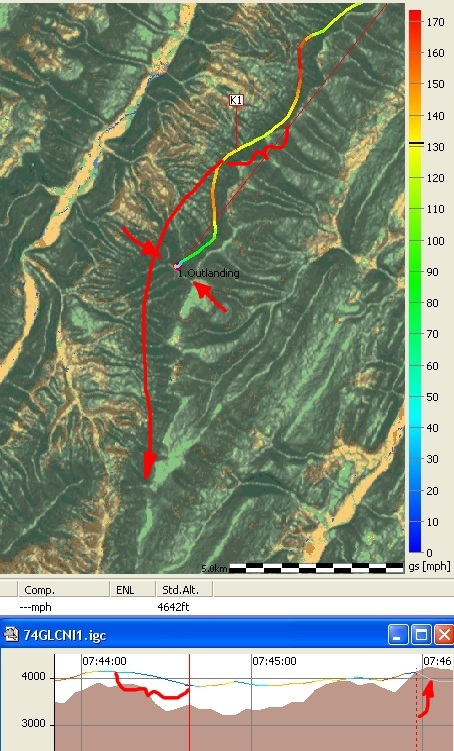
It has been 2 years since the crash and I've had a long time to think about what would I do next time.
There were a couple of signs I missed at the time and a distraction that added to the mix. First, the cloudbase did force me down to an altitude that would make rounding the corner at the normal height impossible. I realized this too late. I was intent on getting that first view of the ridges around the corner, which is always spectacular. When the spine came up, at first I decided to slow up a bit and get close to cloudbase. This should have got me over it but I could see this wasn't going to happen comfortably so I decided to turn out the spine and fly around it. I didn't get the chance, all of a sudden my controls went limp. NOTHING, absolutely no forces on any axis. I immediately glanced at my airspeed and it was in the low 70's (knots). My nose pitched down 45 degrees or more, there was no rotation and a few seconds later I impacted the trees, 300 feet below the entry of this dive. Obviously I flew into severe rotor/downwash. I do not believe that the local topography could have generated that amount of downwash. I believe that the cloudbase was being suppressed by a rotor coming off the upwind ridges and valleys just a couple of miles away.
SO, next time, I will be wary of suppressed cloudbases and when confronted by them I will head away from the ridge and get some more height above the ground.
AND, that leads us to my 'Next time' path you see on the left.
Snow Mountain
Corner
Last spine
before
Snow Mountain
'Next time'
path
Forced down
by cloudbase
Impact
Forced down
by cloudbase
AND, you can bet that the next time I get near that 'last spine before Snow Mountain' I will be giving it a wide berth regardless of the cloudbase, besides, going south, there is no need to be above the 'corner' as the ridges south of Snow Mountain are at least 500 feet lower anyway.
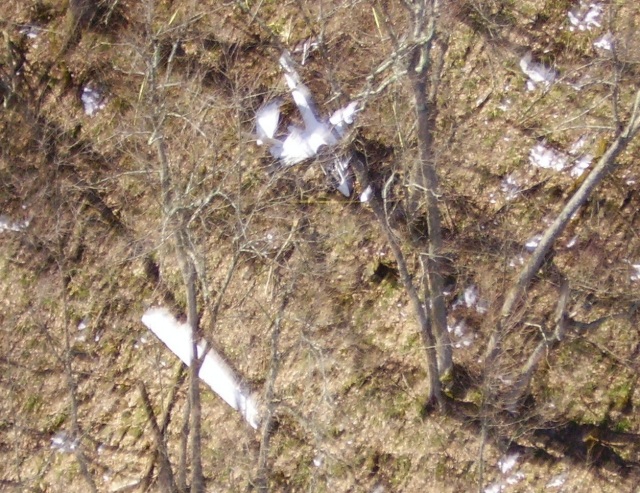
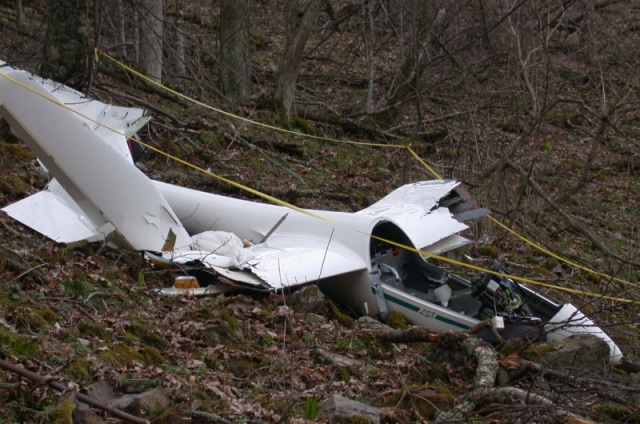
Taken well after the crash, the fuselage was inverted on top of me and against a tree at 8:45 am April 16,2007
One of my favorite pictures to remind me of how lucky I was. How did I find two limbs so close together to take the wings off like that. This is the first thing that saved my life, those two tree limbs absorbed most of the energy of my lawn dart descent. If only one wing had hit a limb, the front fuselage would have taken the rest of the impact and shattered completely with me inside it.
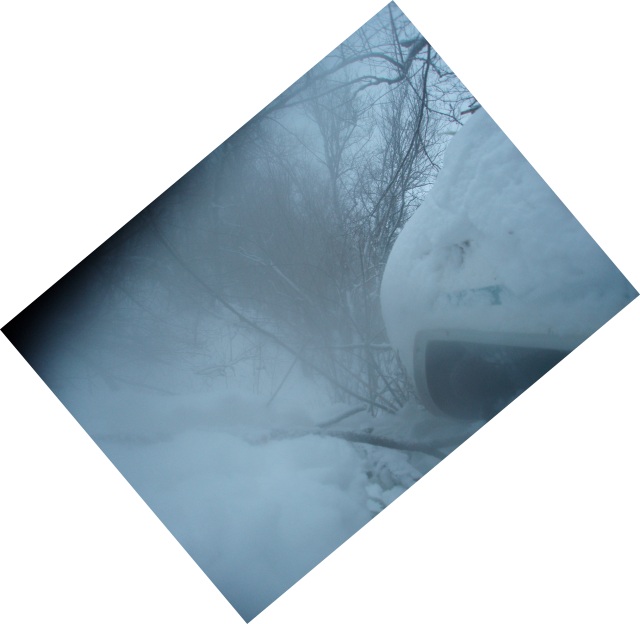
I did not find my camera until after dark the first
day so these pictures are taken after sunrise
the next morning. I was laying on my back
with half my body under the inverted
forward fuselage shown here. My
right arm was my only limb with-
out broken or cracked bones.
I took this picture reaching
over my body with my
right arm. My right
foot is trapped
in the nose
section.
My list of injuries:
2 or 3 cracks in the left
fibula radiating into left
ankle joint, a broken left fibula
and tibia, a broken left femur, a
cracked vertebrae, a cracked rib, a
broken left humerus, a chip in my right
ankle, a broken right fifth metatarsal, minor
frostbite on both feet, and a few cuts and
scrapes that never bled much.
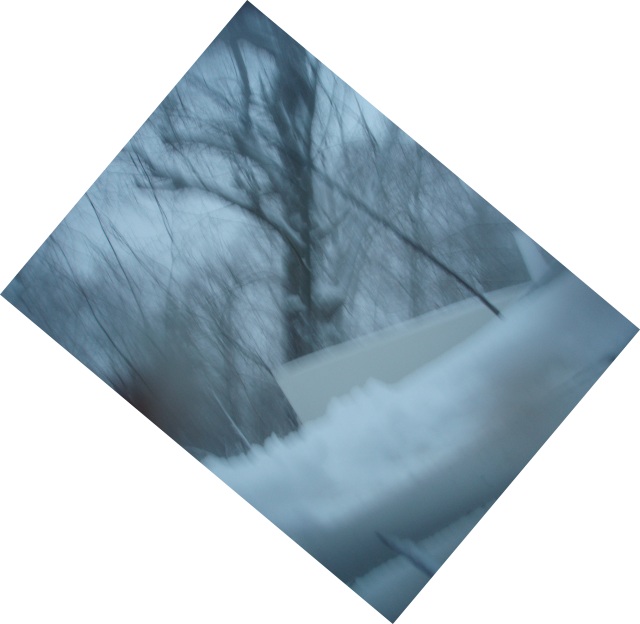
My head
was trapped
under the right
wing stub and right
fuselage side canopy
rail (the uphill side) so I
could not look around. I
took these picture to see if there
was anything worth seeing out there.
I just had normal indoor clothes on and I
was very cold. The smallest gap in my thin
parachute cover was very noticeable.
This is a view looking backwards, over the right
wing stub. I'm told 12 inches of snow fell
on me overnight. One of the first things
I did was to pull the ripcord on my
parachute and then I put as much
of it as I could over me. That
was not easy with only my
right hand. I could not
get the chute over
either foot, hence
the frostbite.
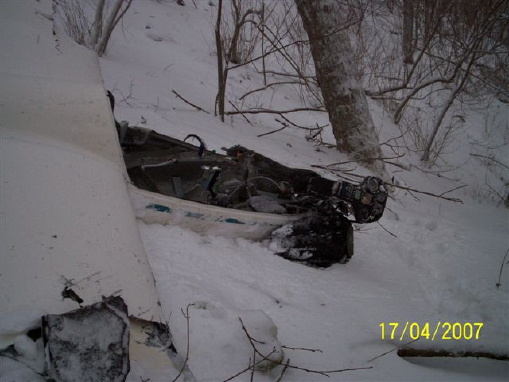
This was taken by one of the rescuers. This is the only shot that shows how much damage was done to the left side of the cockpit and hence all the injuries on my left side. I was trapped there for about 24 hours and I never closed my eyes once. I had to keep busy doing something, anything. I did a lot of things to try to get some comfort. I groped everywhere my right hand would reach. You would be surprised what contortions you can do if you have to. I found my water supply, my camera, and removed a shoulder strap to use as a sling for my left arm. Everything I did took an excruciatingly long time. By nightfall I couldn't stand the pain in my left arm. It was broken between the elbow and shoulder. The break was bent over well past 90 degrees and my arm was contorted and trapped under my body. I was determined to fix this. It was a way to stay awake. I reached across my body with my right hand and started excavating a hole in the semi-frozen, rock infested ground. If I made the hole deep enough, my left arm would fall down in it and then I could grab it and straighten it out. It took hours, in fact most of the night to dig the hole. I had no tool. I could only get a very small bit with each attempt and then I had to open my cocoon and throw the bits of earth and rock down towards my left foot. It took minutes each time to close my cocoon, mostly trying to get the thin material to stay in place over my head. Eventually I had the hole deep enough to try to pull my arm out from under me. With all my strength and body twisting I got my left arm in place onto my chest. But, it wouldn't stay there. It kept falling into the hole and that wouldn't let me twist my body level to relieve the stress on my broken left femur. That is when I reached behind me and removed my shoulder strap from the wreckage. With that and a lot of effort, I got it around my neck and left arm and then tied a knot in it with one hand. That was finally the answer. I was able to twist into a level position with my left arm on my chest and my left femur relatively straight. And, now it was getting light out.
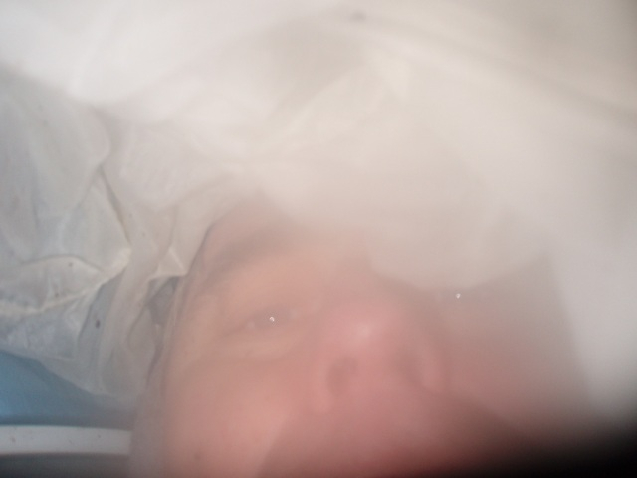
Probably my favorite picture. I took this just after I got my sling on and got a little comfortable. Then I spent most of the time I had left trying to repower my cell phone, either with the camera battery or from some wiring on the glider that I could reach. I wasn't successful, only so much you can do with one hand and a mouth, but I tried and it kept me awake for a long time. The last thing I did was not the smartest. I decided that at any cost I was going to get untrapped and slide myself down the mountain. I spent a long time maneuvering myself back and up under the wing stub, hoping to free my right foot from the nose section. I had one last push until my head was stuffed into the smallest space but my foot still did not drop out. Now I was stuck in the most uncomfortable position yet. Within minutes of this I heard voices, I yelled, they heard me and my ELT which had been blaring in my ear for 24 hours or so. Three great young guys arrived and I was so impressed that they listened to me and did exactly what I said to free me. Some people would have said he is just delirious and we'll get him out, but they had to do it in the right sequence or I would have been twisted up some more. I got them to lift the nose until my right foot dropped out and then they had to flip the plane over downhill while holding me from rolling down after it. It took about 5 hours to get me off the mountain and I can tell you that I got colder coming down than I would have if I stayed in the plane.
If any of you 3 guys who found me read this, please send me your names and/or your story. Also, the local CAP and S&R guys, you were all so important in the search that found me and got me off that mountain. From the cell phone analysis to the care and support given to Carmen. Email me at kci@vaxxine.com.
Also, I want to tell you how the Pennsylvania Civil Air Patrol was involved in the search. One of the first people Carmen talked to after my phone call was the Commander of the PA CAP, Arnie Andreson. Arnie was so good to us, words can't describe. Usually, the CAP wings stay within their own state, not Arnie. He mobilized a crew that drove down to West Virginia with a direction finder for my ELT and they picked up John Good on the way. John was so frustrated at Bedford, he did a little damage to his plane on a runway light, he had no vehicle, no crew to get his airplane and he had to get to WV somehow. John almost commandeered the airport courtesy car but the ride Arnie provided was key and a life saver. Arnie also made his way to WV to help out directly and Arnie visited the Cumberland hospital, how is that for dedication? Thank-you Arnie.
Goto
|
|
|
Click on page
K1 - April 16, 2007 - beginning to end






